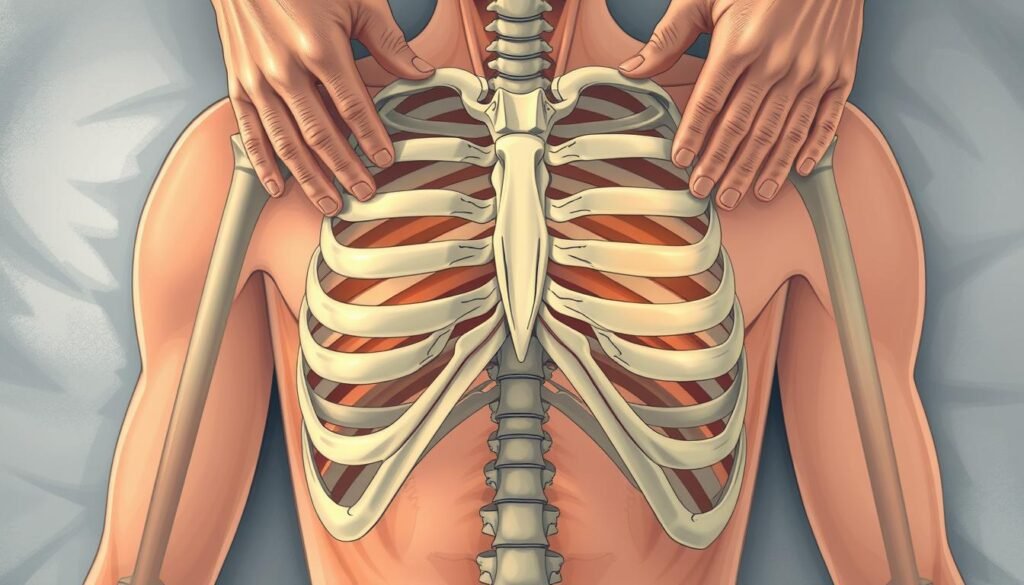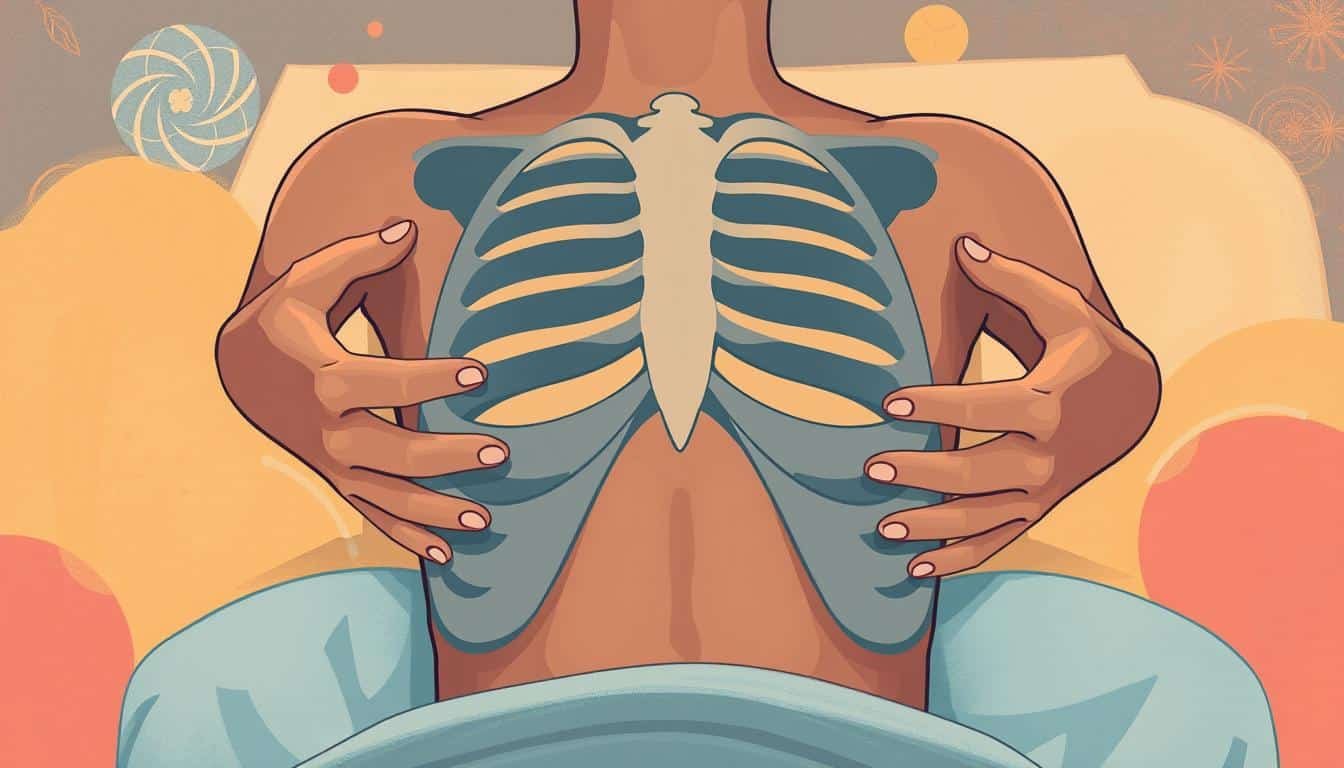Ever felt like your chest is stuck in a vise, making breathing hard? A tight rib cage can quietly ruin our well-being, affecting posture and mood. I’ve been there, and finding relief was life-changing. Let me share some massage techniques that can help you breathe better and move more easily.
In this guide, I’ll show you how to massage tight rib cage areas well. We’ll look at different massage techniques and ways to ease rib cage tension. These strategies are great for athletes or anyone who sits a lot, improving daily comfort and health.
Key Takeaways
- Learn to identify signs of rib cage tightness
- Discover effective self-massage techniques for the rib cage
- Understand the importance of rib mobility for breathing and posture
- Explore tools and methods for targeted rib cage release
- Combine massage with breathing exercises for optimal results
- Recognize when to seek professional help for persistent tightness
Understanding Rib Cage Tightness and Its Impact
Rib cage tightness is a common problem that can really affect our daily lives. Many people don’t realize how much it can impact our well-being. Let’s look at what causes it, its effects, and how to spot it. This will help us see why chest massage and myofascial release are key.
Common Causes of Rib Cage Tension
There are many reasons for rib cage tightness. Stress, bad posture, and not moving enough are common causes. Injuries or certain health issues can also play a part. Knowing what causes it is key to treating and preventing it.
Effects on Breathing and Overall Well-being
A tight rib cage can really mess with our breathing. We breathe about 24,000 times a day, and a tight rib cage makes it hard. This not only affects our breathing but also our health and happiness.
| Normal Breathing | Breathing with Tight Rib Cage |
|---|---|
| Deep, full breaths | Shallow, labored breaths |
| Efficient oxygen intake | Reduced oxygen intake |
| Relaxed chest muscles | Tense chest muscles |
Signs and Symptoms of a Tight Rib Cage
It’s important to know the signs of a tight rib cage. Look for signs like not being able to expand your chest, shallow breathing, and pain in your chest and back. These signs mean you might need treatments like chest massage or myofascial release.
Understanding rib cage tightness helps us see why we need to treat it right. Regular chest massage and myofascial release are important. They help keep your rib cage moving well and your breathing healthy.
The Importance of Rib Cage Mobility

Rib cage mobility is key to our health and happiness. Keeping this area flexible is essential for good breathing and body function. Doing exercises for rib cage mobility boosts our posture and breathing.
The rib cage moves with each breath. Its joints allow the ribs to adjust with the spine. This movement is vital for breathing in and out.
When the rib cage can’t move well, problems arise. It can lead to bad breathing and posture issues. That’s why doing exercises for the rib cage is crucial.
“A flexible rib cage is the foundation of good breathing mechanics and optimal physical performance.”
Being able to move the rib cage freely is beneficial in many ways. It helps us breathe better, relieves back pain, and improves our posture. Taking care of our rib cage mobility is a smart investment in our health.
Preparing for Rib Cage Massage: Essential Tools and Techniques
Getting ready for a rib cage massage needs some prep work. I’ll show you the key tools, how to set up your space, and safety tips. This will help you have a great intercostal muscle massage.
Recommended Massage Tools
You’ll need the right tools for a good rib cage massage. Massage balls are perfect for focusing on specific spots. Foam rollers are great for bigger areas. And don’t forget your hands for gentle pressure.
Creating a Comfortable Environment
Make a cozy space for your massage. Pick a quiet room with soft lights and a comfy temperature. Use a yoga mat or soft surface to lie on. This setup will help you focus on the massage.
Safety Precautions and Contraindications
Know the safety tips before you start. Don’t press too hard on floating ribs. If you’ve had injuries or infections recently, wait until you’re better. People with health issues should talk to their doctor first.
- Start with gentle pressure
- Stop if you feel pain
- Avoid massaging over bruises or cuts
- Don’t massage if you have a fever
By following these tips, you’ll be ready for a safe and effective massage. The goal is to ease tension and improve movement without pain.
How to Massage Tight Rib Cage: Step-by-Step Guide

Massaging a tight rib cage can help you feel better and move easier. I’ll show you how to do it right to ease tension and pain.
Assessing Rib Mobility
First, check how well your ribs move with the “piano key” method. Press each rib gently and see if you feel any pain or tightness. This tells you where to focus your massage.
Erector Spinae Release
To loosen tight erector spinae muscles:
- Lie on your back with a foam roller under your spine
- Slowly roll up and down, focusing on tender spots
- Breathe deeply and relax into the pressure
Costovertebral Joint Mobilization
For costovertebral joint mobilization:
- Find the joint where ribs meet the spine
- Use your fingertips to apply gentle pressure
- Move in small circles to increase mobility
Intercostal Space Expansion
To expand intercostal spaces:
- Place your fingers between two ribs
- Take a deep breath in
- As you exhale, gently press to create space
- Repeat for each intercostal area
Be patient when learning to massage your tight rib cage. Use gentle pressure and give your body time to adjust. These techniques can greatly improve your comfort and breathing if done regularly.
| Technique | Duration | Frequency |
|---|---|---|
| Erector Spinae Release | 5-10 minutes | Daily |
| Costovertebral Joint Mobilization | 2-3 minutes per joint | 2-3 times per week |
| Intercostal Space Expansion | 30 seconds per space | Every other day |
Targeting Specific Rib Cage Areas

When I do a chest massage for tightness, I focus on areas that are stiff. The rib cage has different parts, each needing its own special care. Let’s see how to target these areas well.
For the upper rib cage, I use soft circular motions with my fingertips. This helps loosen the pectoralis minor and intercostal muscles. The middle part does well with long strokes along the ribs. I also focus on the spaces between the ribs, where tension builds up.
The lower rib cage needs a different method. I use my palms for steady pressure here. This helps the diaphragm and improves breathing. For women, I’m careful around bra strap areas, as they can hold a lot of tension.
During the massage, I adjust the pressure based on what feels right for the client. Some spots need more pressure, while others are better with a light touch. By treating each part of the rib cage, I make sure the massage is thorough. This helps improve chest mobility and comfort.
Incorporating Breathing Exercises with Massage
Breathing exercises are key to making rib cage massage more effective. They help release tension and improve mobility. By using both, you get better results.
Diaphragmatic Breathing Technique
Diaphragmatic breathing is great for easing rib tightness. Place one hand on your chest and the other on your belly. Breathe in deeply through your nose, letting your belly rise while your chest stays still.
Breathe out slowly through your mouth, feeling your belly fall. Do this for 5-10 breaths.
Rib Cage Expansion Exercises
Exercises for rib cage mobility can really help. Stand with your feet hip-width apart. Raise your arms up, breathing in deeply.
As you breathe out, lower your arms and bend to one side. Feel the stretch in your ribcage. Then, go back to the middle and do the same on the other side. Do 5-10 repetitions on each side.
Combining Breath Work with Self-Massage
Adding breathing to your self-massage routine boosts its benefits. When you press on tight spots, breathe in deeply. Focus on expanding that area.
Then, breathe out slowly, letting the muscles relax. This mix of breathing and massage can lead to deeper relaxation and better rib cage mobility.
Stretches and Exercises to Complement Rib Cage Massage
Combining stretches for tight rib cage with massage techniques boosts flexibility. Let’s look at some exercises that can enhance your massage results.
Intercostal muscle stretches are crucial for relieving rib tension. I start by standing tall and raising my arms overhead. Then, I lean to one side, feeling the stretch along my ribs.
Holding for 15-30 seconds on each side is very effective.
For pectoral stretches, I stand in a doorway. I place my forearms on the frame and lean forward. This opens up my chest and improves mobility.
I hold this position for 30 seconds, repeating 2-3 times.
Rib cage mobility exercises like the cat-cow pose are great for flexibility. I get on all fours, arch my back upward (cat), then dip it downward (cow). This movement loosens up the rib cage area.
| Exercise | Duration | Benefits |
|---|---|---|
| Intercostal Stretch | 15-30 seconds per side | Relieves rib tension |
| Pectoral Stretch | 30 seconds, 2-3 reps | Opens chest, improves mobility |
| Cat-Cow Pose | 5-10 reps | Enhances thoracic flexibility |
Adding these stretches and exercises to your routine can greatly improve flexibility. It also complements your massage efforts.
Post-Massage Care and Maintenance
After doing a self-massage for rib pain, it’s key to follow the right care and maintenance steps. These steps help get the most out of your rib cage massage techniques. They also help keep your body mobile for a long time.
Hydration and Rest
Drink lots of water after your massage. This helps get rid of toxins and aids in tissue healing. For the next 24 hours, rest and avoid hard activities to let your body heal.
Massage Frequency
For the best results, do rib cage massage techniques 2-3 times a week. This schedule lets your body heal and adapt between massages. It keeps the benefits of self-massage for rib pain going.
Long-term Mobility Strategies
To keep your rib cage mobile over time, add these to your routine:
- Regular stretching exercises for the chest and back
- Deep breathing exercises to open up your rib cage
- Keeping good posture all day
- Doing activities that boost flexibility, like yoga or Pilates
By sticking to these post-massage care tips and long-term strategies, you’ll make your self-massage for rib pain more effective. You’ll also keep your rib cage mobile for a long time.
When to Seek Professional Help
I know self-massage can help a lot with a tight rib cage. But sometimes, it’s not enough. If you’ve tried chest massage and still feel pain, it’s time to get help from a pro.
Massage therapists, physical therapists, and chiropractors can help with rib cage issues. They use special techniques like myofascial release. This can be more effective than doing it yourself. They’ll create a plan just for you, focusing on your needs.
Don’t ignore tightness in your rib cage. If self-care isn’t working, get help from a healthcare professional. They can find the cause and give you treatments that fit you. Getting help early can stop small problems from getting bigger.
FAQ
What are some common causes of rib cage tightness?
How can rib cage tightness affect my overall well-being?
Why is rib cage mobility important?
What tools are recommended for rib cage massage?
How can I assess my rib mobility?
What techniques can be used for erector spinae release?
How can I mobilize my costovertebral joints?
What is the technique for intercostal space expansion?
How can I incorporate breathing exercises with rib cage massage?
What stretches and exercises can complement rib cage massage?
How often should I perform rib cage massage?
When should I seek professional help for rib cage tightness?
Source Links
- No title found – https://www.bouldertherapeutics.com/myofascial-release-therapy-for-your-ribs/
- Better Breathing: Myofascial Techniques for Rib Restrictions – https://www.massagemag.com/better-breathing-myofascial-techniques-for-rib-restrictions-132067/
- Self Massage for Rib Meat | The muscles between your ribs are super important for #breathing, and dysfunction can even attribute to mid #backpain. Join us to learn how to… | By Life Moves Manual Therapies | Facebook – https://www.facebook.com/LifeMovesMT/videos/self-massage-for-rib-meat/1155623118192689/













6 Comments
Interesting read! But is there any correlation between rib cage tightness and posture? Could poor posture exacerbate the issue?
Interesting read but isnt it risky to self-massage the rib cage area without proper guidance? Could easily aggravate existing issues. Thoughts?
Isnt it surprising how rib cage tightness can dramatically affect our overall well-being? Any more effective massage techniques to share?
Interesting read, but could these techniques potentially worsen underlying conditions like rib fractures? Safety should be paramount, right?
Absolutely, safety first! But dont let fear stifle progress. Proper usage ensures safety.
Interesting read! But wouldnt yoga or pilates be equally effective in relieving rib cage tension without the need for massage?